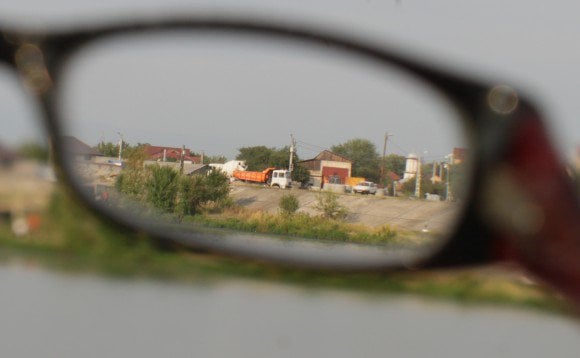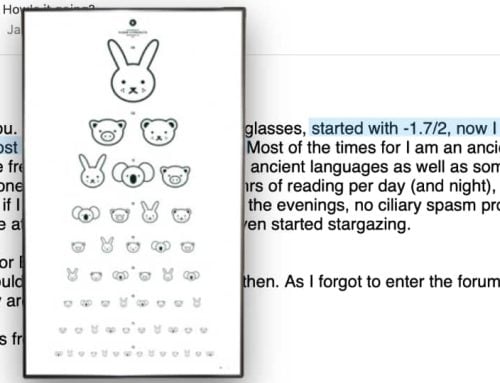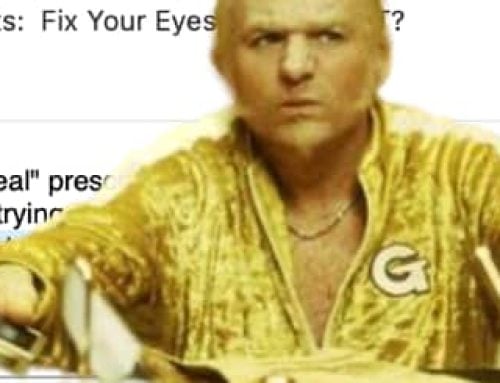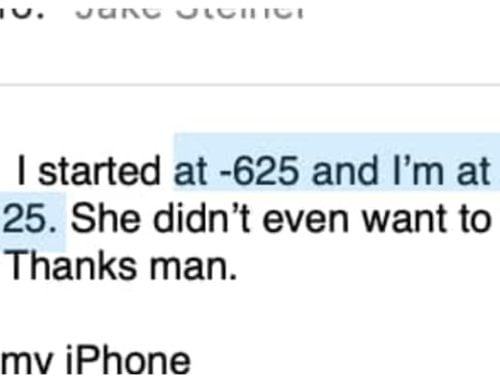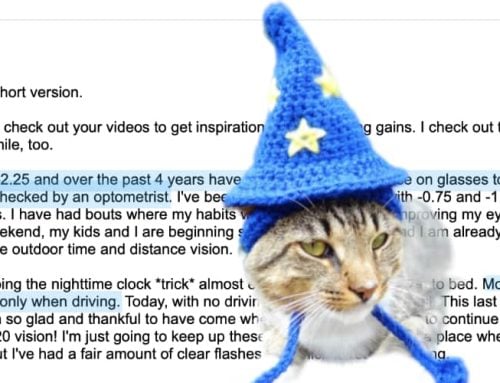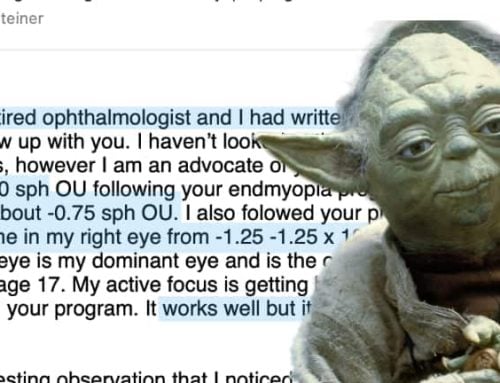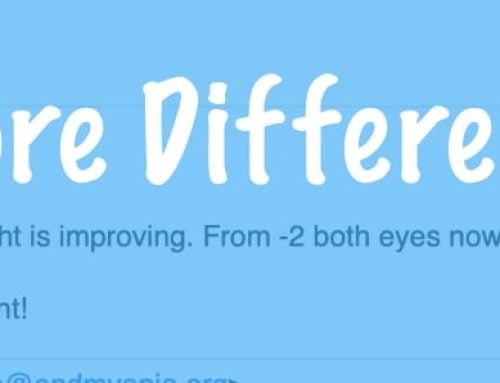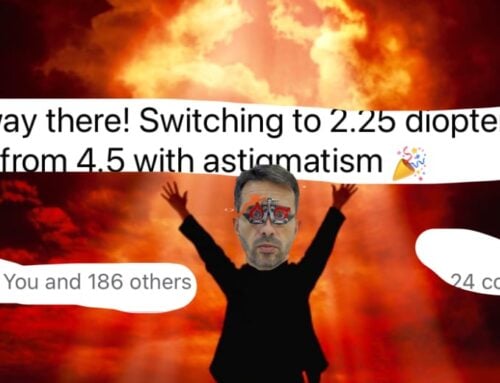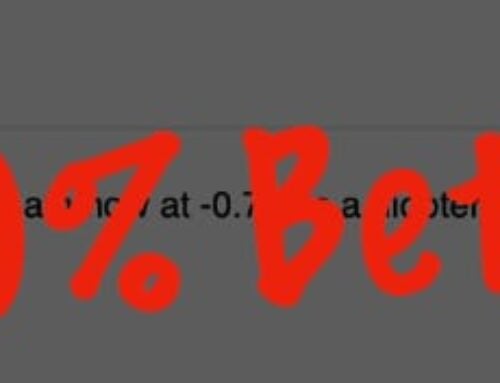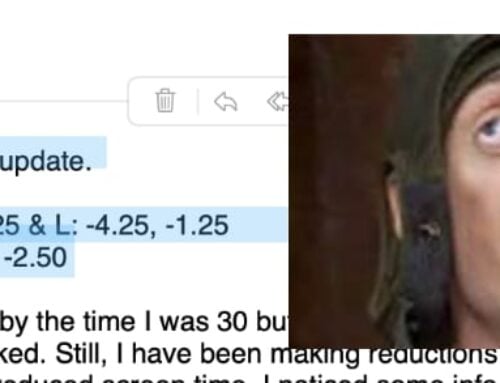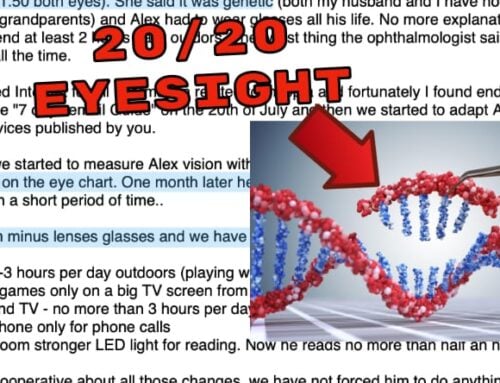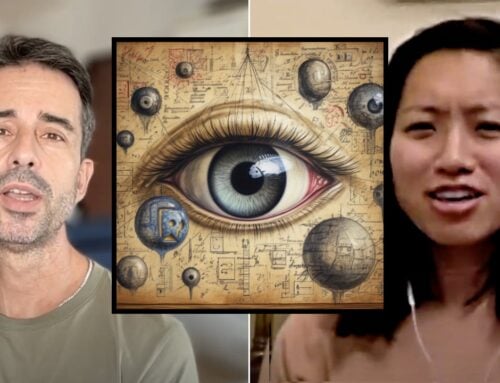Today was going to be a no-blog day but alas, I can’t skip Matthew’s BackTo20/20 forum post:
I’m one month into a fully equalized set of lenses at -1.25 / -1.25. I spent 100 days with the L -1.25 / R -1.50. I checked at the end of those 100 days, and again after 30 days on the -1.25 / -1.25 to see how my right eye was doing. I can see the 20/30 line on the Snellen with the -1.50 and the 20/25 in good lighting.
The leap down to -1.25 has been quite challenging. After 30 days, I’ve seen some improvement, but it loos like this one is going to take awhile. I’m okay with that because I know my improvement has been fast. I thought, during this first 30 day period, that I might have just pushed myself too far. After all, if I were improving at the average rate Jake talks about of 0.75 diopters per year, I would now be at L-1.50 / R -2.50. Yet, I use an old pair of -1.75 / -1.75 glasses for driving, and during the day, they feel so strong that I can hardly stand to wear them. At night, I can read signs with them perfectly well. They feel strong at night, too, but I’m not going to wear any less correction for safety’s sake. I’ve been fortunate to make fast progress.
As best I can tell, the -1.50 is too strong for me now, but the -1.25 is too weak. It feels uncomfortable for me to wear the -1.50. I’m going to continue with the patching and see how my right eye progresses. My guess is that it will lag through the low light of the later fall and winter, and improvements will show up again in the spring.
I only point at the difference in my progress versus the 0.75 diopters per year rate of improvement because it looks like I’m in a plateau and potentially facing some “payback time” on my right eye. The leap from -1.50 to -1.25 is a pretty big one of course. I am thinking, though, that the lower light months are a good time to work on equalization, which is one of the final factors in being able to leap to having functional vision without glasses.
Here’s some other observations:I’m starting to see clear images without glasses on sunny days outside. There’s a sort of “layer” of other “stuff” obscuring the clarity, alongside double vision, but I can feel that clarity is there.
I’m finding myself spending more time without glasses, but not intentionally. There’s certain times when they just don’t feel good to wear (like changing a diaper for our baby, playing with toys with my 3 year old, or other activities within arms length). My 20 minutes without glasses in the morning has turned into 1 – 2 hours most days, not because I think this is the “right” amount of time, but just because it feels better, despite the blur.
Before I knew about all this endmyopia stuff, not wearing glasses felt something like being dropped into a country where I don’t speak the language and don’t know any of the words. Just plain confusion and hopelessness. Now, it varies from moments of hopeful clarity to simple blur. I say simple blur because it no longer feels like complete visual chaos. I can look across my kitchen and say, “that’s a toaster. It’s blurry, but I know what it is.” That’s a dramatic step up.
For short periods of time, I am able to watch TV / movies with no glasses and read the subtitles (through a good bit of double vision).I might point out, that my first “prescription” for glasses was L-1.25 / R -1.50. Even though that was an over”prescription” and the -1.25 / -1.25 is a deliberate undercorrection, I am experiencing functional vision with it. There’s something deeply psychologically satisfying about wearing less correction than I ever have in my life, even if I might be pushing myself a little faster than I should.
Jake recently reposted the links on dealing with low myopia, which were very timely for me. My question has been, “how do I go from here, where I definitely still need the glasses, to being able to function without them?” I anticipate “phases” over the next year, that will look something like this:
1. Spend the coming months of lower light with some eye patching and working on getting my right eye to catch up to the left as much as I can.
2. Once spring comes, get outside and spend time without glasses. Good daylight hours in Virginia begin in late March to early April. I expect by then my vision in good lighting, outdoors, will be relatively functional.
3. Note, as time progresses, environments where I can see well without glasses where I couldn’t before, such as: outdoors on a cloudy day or indoors with good ambient lighting.
At some point, if it makes sense, I may try a -1.00 / -1.00. My wife has a pair of those, so it’s easy enough to test.
I also could try using a 0.50 plus lens. I haven’t fooled with plus lenses much. Most of my close up time comes at work. I’ve switched to a stand up desk and wireless mouse and monitor, so I simply back up to a good distance to limit ciliary strain. Without glasses, this works just fine and I haven’t seen a reason to scoot up closer and use a plus.One other special, very meaningful experience. Our second child, a boy, was born at the end of July. It was a relatively quick labor, and being close to my wife during the labor, I was able to watch my son be born without wearing glasses. There’s something powerful for me about knowing that the first time he saw me, it was without glasses. Onward we go!
October 19 2015 L: sph -1.75 cyl/axis -.025 177
R: sph -2.25December 30 2015 L: -1.50 / R: -2.00
Differential: no glassesMarch 18 2016 L: -1.25 / R -1.75
June 18 2016 L: -1.25 / R -1.50
September 28 2016 L: -1.25 / R -1.25
Full thread, including some suggestions from me, here.
The transition from low myopia to no-myopia is a fun one. You get to wear the crutch less and less, get a little further and further every time. It’s nothing short of a revelation, an incredibly liberating experience.
That’s it. Time to get on a 6-hour bus ride, go find my other motorbike. Go work on those 20/20 gains, kittehs!
Cheers,
-Jake

